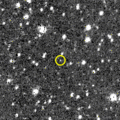Carme (moon) facts for kids
| Discovery | |
|---|---|
| Discovered by | S. B. Nicholson |
| Discovery date | July 30, 1938 |
| Orbital characteristics | |
|
Mean orbit radius
|
23,400,000 km |
| Eccentricity | 0.25 |
| 702.28 d (2.045 a) | |
|
Average orbital speed
|
2.253 km/s |
| Inclination | 164.91° (to the ecliptic) 167.53° (to Jupiter's equator) |
| Satellite of | Jupiter |
| Physical characteristics | |
|
Mean radius
|
23 km |
| ~6600 km² | |
| Volume | ~51,000 km³ |
| Mass | 1.3×1017 kg |
|
Mean density
|
2.6 g/cm³ (assumed) |
| ~0.017 m/s2 (0.0017 g) | |
| ~0.028 km/s | |
| Albedo | 0.04 (assumed) |
| Temperature | ~124 K |
Carme is one of Jupiter's many moons. It's a bit unusual because it orbits Jupiter backward! This is called a retrograde orbit. Carme is also not perfectly round like a ball.
A scientist named Seth Barnes Nicholson discovered Carme in July 1938. He found it using a telescope at the Mount Wilson Observatory in California. Carme is named after a character from ancient Greek myths. She was the mother of a goddess named Britomartis.
How Carme Got Its Name
Carme didn't always have its current name. For a long time, it was just known as Jupiter XI. It was the eleventh moon found orbiting Jupiter.
Between 1955 and 1975, some people even called it "Pan". But now, Pan is the name of a different moon. That moon orbits Saturn, not Jupiter. Carme finally got its official name in 1975.
The Carme Moon Family
Carme is part of a family of moons called the Carme group. All the moons in this group are like Carme. They orbit Jupiter backward and aren't perfectly round.
These moons orbit Jupiter at a similar distance. They are usually between 23 million and 24 million kilometers away. Their paths around Jupiter can change a bit over time. This is because the Sun and other planets can slightly pull on them, affecting their orbits.
Images for kids
See also
 In Spanish: Carmé (satélite) para niños
In Spanish: Carmé (satélite) para niños


